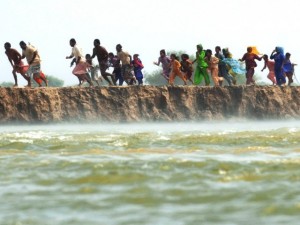Sindh still lurking in shadows after the massive rainfall and floods: Part-2
Wednesday, January 4th, 2012 2:32:18 by Naveed A Bari
Sindh still lurking in shadows after the massive rainfall and floods: Part-2
Agriculture pointedly contributes to the food security and livelihoods of rural communities in Pakistan. However, flooding has deeply reduced the capacity for farming households to earn income as yields have dropped. This is exacerbated by poor quality inputs
(seeds) and lack of managed inputs (irrigated water). Overall, farming communities in poverty-stricken rural Pakistan are not practicing progressive agricultural practices that can overcome environmental conditions and advance stronger yield toward more sustainable
food security and income.
Opportunities are not extensive to promote the value of improved planting, harvest, and key crop management methodologies. Grassroots level farming households lack access to training opportunities that can build their capacity to leverage out of subsistence
and into improved. This extends into the management of livestock and their health, which often declines product values for poultry and cattle, among other impacts. Lack of veterinary health resources and awareness of veterinary health issues and simple treatments
is further depressing this important food security resource.
Although the government of Pakistan and NGOs are struggling to address the issue, the magnitude is at near emergency levels impacting poverty rates and deepening malnutrition status for the most vulnerable. According to a World Bank analysis, 52% of Pakistan’s
population lives below the national poverty line, with 36% urban population living below the poverty line. A June 2008, United Nations Inter-Agency Assessment revealed that the estimated number of households in Pakistan falling in to the severely food-insecure
category is estimated to be around 7 million.
To address the interconnected issues of flooding, low agricultural yield, poor farming skills, and food prices, the project will support subsistence farming households with improved inputs and skills training to build their capacity for production toward
improved outcomes in food security and livelihoods.
1.2 million Homes have been destroyed and victims have lost over 120,000 cattle due to diseases caused by the floods. Hundreds of thousands more livestock and poultry are at risk as water-borne diseases multiply. To make matters worse, the livestock that
has survived might die of starvation as fodder has been washed away. The fate of poultry and fish farms has been similar, dealing another severe blow to thousands of livelihoods. That in turn may give rise to massive food shortage and food insecurity and the
amount of time it will take to regain use of agricultural land will cost the economy greatly.
The capacity of people of Badin to maintain adequate food consumption and re-establish livelihoods has been further constrained due to numerous challenges including destruction of roads, no employments due to floods, soaring costs of transportation, and
poorly-functioning markets. Badin stands now at the most vulnerable point. Crops in Badin have reportedly been completely destroyed. To rebuild their livelihoods, people need interventions that could enable them to use their skills of farming to improve their
living.
Short URL: https://www.newspakistan.pk/?p=8161

















